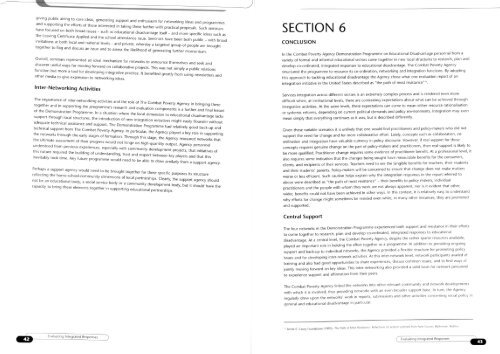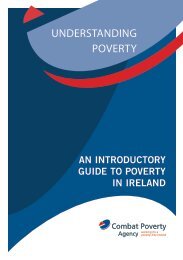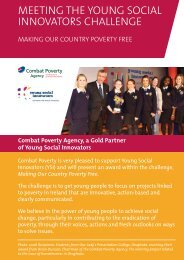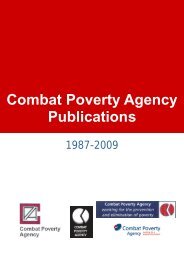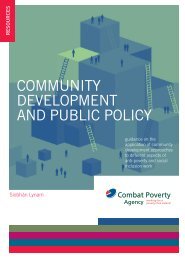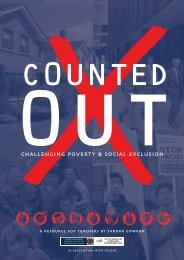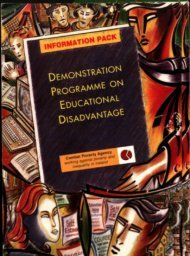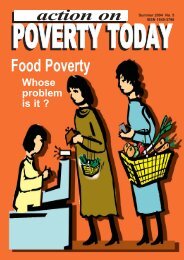Evaluating Integrated Responses to Educational Disadvantage (2000)
Evaluating Integrated Responses to Educational Disadvantage (2000)
Evaluating Integrated Responses to Educational Disadvantage (2000)
- No tags were found...
You also want an ePaper? Increase the reach of your titles
YUMPU automatically turns print PDFs into web optimized ePapers that Google loves.
A particular effort was made <strong>to</strong> bring parents on board. When the steering committee was set up initially, itwas seen as unbalanced as there were few parents compared <strong>to</strong> professionals. The committee expanded <strong>to</strong>include more parents. Meetings were changed from daytime <strong>to</strong> night <strong>to</strong> facilitate parental participation. Theinvolvement of more parents brought fresh enthusiasm, contributed <strong>to</strong> greater morale and promoted a senseof openness.The success of an application for the 8-15 Early School-Leavers Initiative (ESLI) also provided a focus forgenerating more lobbying momentum within the network. KEN became recognised as an important structurefor facilitating the co-ordination of such activities. In particular, it was seen as helpful for groups in accessingfunding and other supports. It organised an information poster on voluntary youth and sports groups thatwas distributed widely in the community. School principals and other key local figures collaborated with KENin highlighting the area's educational needs and bringing these <strong>to</strong> the attention of the Department and theMinister for Education.Lobbying also provided a focus for promoting the development of a school attendance committee. Highlevels of absenteeism had caused widespread concern and a committee was drawn <strong>to</strong>gether <strong>to</strong> giveleadership <strong>to</strong> whatever interventions might result. The committee drew <strong>to</strong>gether representatives from theschools, Youthreach, Garda Sfochana, health board and KEN. It developed a set of guiding principles and anoutline modus operandi. The publication of the Education Welfare Bill 1999 has helped provide a context forthe committee's work but there is a strong sense that a specific agency is needed <strong>to</strong> deal with this problem(see below, Lessons). KEN hopes that, in the long-term, when issues of confidentiality and case managementpro<strong>to</strong>cols are adequately resolved, case conferencing for early school-leavers will take place.The network initiated a family literacy programme. This was a 10-week programme organised with thesupport of KEN in a single school. It <strong>to</strong>ok place in a family room at times that suited parents dropping theirchildren off <strong>to</strong> school. The programme made a lot of use of home-based materials and developed parents' useof these. Sessions involving children also followed at a later stage. The main involvement of the network was<strong>to</strong> play a supportive and funding role.KEN's involvement gave an opportunity <strong>to</strong> evaluate the programme's impact. To avoid stigma, theprogramme had been offered on a general basis in the school. Those who joined, however, were already quiteactive and engaged in educational support work with their children. Some parents who had been targetedhad dropped out. Through the network's supportive role, the issue of more effective targeting for futureprogrammes was raised. Without its involvement, such programmes might have been repeated withoutreflection or analysis.On a separate level, KEN collaborated with St. Patrick's College for teacher training in developing an electivecourse on the <strong>to</strong>pic: Teaching in an Area of Social and Economic <strong>Disadvantage</strong>. It also helped <strong>to</strong> organisepoverty awareness in-service training with 20 teachers in local schools in conjunction with the CurriculumDevelopment Unit and The Combat Poverty Agency.RoleKEN has adopted a role around generating ideas, initiating discussions and consultations, buildingrelationships and fostering a sense of responsibility for management among other partners: schools, parentsand community bodies. However, it does not manage projects itself.While waiting for enactment of the Education Welfare Bill 1999, the committee is focusing on informationsharing and lobbying.Lessonsdraw more organisations in<strong>to</strong> the network. KEN's success in securing the project for the area demonstratedthe potential of its work methods, i.e. concentrating on generating the ideas, bringing the players <strong>to</strong>gether,making the application, supporting the relationships but leaving implementation <strong>to</strong> a separate group thatemerged from KEN's preliminary preparations.The network's activity on school absenteeism gave it a strong sense that a specific agency was needed <strong>to</strong> dealwith this problem and that the schools, whether on their own or working <strong>to</strong>gether or with communityagencies, lacked both the mandate and the capacity <strong>to</strong> have any real effect.KEN's involvement in the family literacy programme showed how the network's development model couldhelp improve existing local educational interventions. In the absence of KEN as an integrative supportmechanism, such programmes might easily be repeated without much analysis or evaluation. KEN'sinvolvement helped <strong>to</strong> ensure that broader community perspectives would inform future programmes.Achievement Profile - What Worked WellSupporting Parental Involvement Through Peer Support and Home VisitingThe network's main activities during 1998-1999 concerned its promotion of parental involvement, whether inrelation <strong>to</strong> involving parents in network structures or in specific programmes. In promoting parentalinvolvement, the network was anxious <strong>to</strong> move it away from traditional roles in fundraising or in helping inthe classroom. It set about developing programmes with a particular focus on parental involvement.Following a series of self-evaluation workshops on this <strong>to</strong>pic, it decided <strong>to</strong> prioritise a practical interventionaimed at overcoming parental fears about engaging with schools. One way of doing this would be <strong>to</strong>combine home visiting with peer support. In putting <strong>to</strong>gether a plan, KEN members were always conscious ofparents' fears of the education system and of professional people in particular. Some form of parent-<strong>to</strong>-parentpeer support was seen as essential <strong>to</strong> enable other parents <strong>to</strong> become more involved in the education of theirchildren in a non-threatening way.( J'There is a fear of professionals and a desire among parents not <strong>to</strong> have them calling <strong>to</strong> the door.Peer support was considered more acceptable." (Home-school


